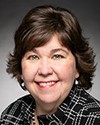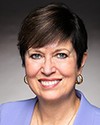Thank you very much, Madam Chair.
It's a real pleasure to be here with you. I know the committee is just getting going, so it's a real privilege to be able to come and tell you a little bit about what we do at Status of Women Canada.
As you said, we're the agency in the bureaucracy that supports Minister Hajdu, who is the Status of Women minister. You'll be hearing from her next week.
I have the pleasure of having my entire management team here, which just shows you what a small but very mighty agency we are.
I have Linda Savoie, who is the director general for women's programs and regional operations. You'll be hearing more about these later. I also have Nanci-Jean Waugh, who is the director general of communications; Justine Akman, who is the director general of policy and external relations; and Anik Lapointe, who is the director of corporate services and our CFO, and who makes sure that we are kept in line.
This is our management team.
Most of my presentation will be in English, but we would be happy to answer any questions you have in the language of your choice.
I know that I have 10 minutes, so I'm going to whip through this presentation. I hope everybody has a copy. I know that we're trying to go paperless here, as Andrew has said, and next time we'll make sure that we're ready to project and make those presentations.
Status of Women Canada was created 40 years ago, and I want to take a minute to talk about the situation of women in Canada and just give you an overview. I'll start on page 1 of the deck.
As you all know, women are excelling in education in Canada. Seventy-five per cent of working-age women have some kind of post-secondary credentials. We have more women than ever before who are employed, with 48% of them in the workforce. Women are also making gains, albeit slowly, in leadership roles, elected office, the private sector, and the public sector. There's a lot more work to be done, but at least we're moving in the right direction.
On violence, which is a huge issue, the only so-called positive thing we can say is that we're starting to get an increased appreciation of the social and economic costs of violence. There is really good data out on that, and we'll talk a bit about that later.
As the two little blue boxes on that page show you, there is an economic imperative to get more women participating fully in Canada's society, whether it's in the social, economic, or political sphere. There are a lot of benefits to that, and there's a lot of economic argument coming out as to why not having them participating fully just doesn't make sense, not only socially or from a public policy perspective, but also fiscally, in terms of the contribution women can make to Canada's economy.
We'll go to page 2. Those are the positive things, so what are the challenges that remain? First and foremost is the wage gap. Women in this country in 2016 still continue to earn less than men. Why they earn less than men and what some of the factors are make up a hugely complex issue. Whether you look at the gender wage gap on an hourly rate basis or an annual rate basis, whether you look at full-time, part-time, and seasonal work, the bottom line, no matter which way you cut it, is that there is a gender wage gap in this country. That has been affecting our international standings as well, which you will see a little later.
Women also do a lot more of the unpaid work than men, including child care, senior care, and caring for the sick. More women are in part-time jobs, and almost 38% of women who are working part-time aren't doing it out of choice. It's not because they want the flexibility, but because they have to work, and these are the only jobs that they're working at.
Women are also facing barriers in key leadership positions and in elected office, even though 26% of this Parliament is made up of women who have been elected. That's progress, but it's still under the 30% that the United Nations says is needed. It says that there needs to be at least 30% women around any table for them to have influence.
We're at 26% in Parliament, while in the private sector—again, the numbers range—it's 17% to 20%. It is growing very slowly in terms of private sector boards. In the GIC appointments in the public sector, it's a little better, at around 34%, but there's a lot more work to be done. Of course, as you know, with this government, half of the members of cabinet—this is history—are women, and that's huge in terms of the symbolism and the leadership that is now percolating in these various sectors.
In spite of these gains in education and employment and leadership positions, women continue to be the victims of spousal and sexual violence. Women represent 80% of police-reported intimate partner violence, and aboriginal women and girls are much more vulnerable. So are immigrant women and women who are seniors and women with disabilities. There is lots of data out there that we need to do a lot more work as a country on violence against women.
As I said earlier, Canada has been losing ground internationally. A lot of these indices have come out. It's primarily because of the gender wage gap and the lack of gender balance in democratic institutions. That's where we're losing ground.
The mandate, on page 3 of our Status of Women Canada document , hasn't changed for the last 40 years, since 1976. I think that you would agree with us that we still need an agency devoted solely to women's issues because even with this agency doing great work for 40 years, a lot more remains to be done. The mandate is broad enough to be able to include virtually anything. Does the mandate of this agency need changing? Our view is that coordinating policy with respect to status of women and administering related programs is broad enough.
We are the lead on gender issues, but we don't have the levers. They are with other departments, so we work with a lot of other departments, which have the actual levers to effect change on gender equality.
What do we do? On page 4, you can see that we have three key roles. First is providing expert advice on issues to other departments within the federal government and internationally. Second is providing financial support so we can try to break down some of the barriers to equality. The third is raising awareness of the opportunities and challenges that women face.
On providing strategic policy advice, page 5, there are three themes. The three priority areas that this agency's been working on are violence against women and girls, with a focus on murdered and missing indigenous women; women's economic security and prosperity, looking at why women are in the lower-paying sectors and why they are not in the non-traditional or skilled trades, which are very male-dominated, in that 95% of skilled tradespeople are male; and women's leadership and democratic participation, where we're trying to push gender parity or increase the number of women on boards in both the private and public sector.
We also advise other federal departments on other issues, such as human trafficking and cyberviolence. With some of our levers, such as the women's program, we try to identify these issues early on so that we can figure out who in the government is best suited to apply the levers to it.
Page 6 deals with gender-based analysis. You might have heard about that in recent days. GBA, for those of you who may not be familiar with it, is a tool that looks at all the policies, programs, and legislation and makes evaluations of programs through a gender lens to see if it affects diverse groups of women and men disproportionately.
We also know it's not just about women and men, and that there are other intersecting factors underneath it, which is what we call GBA+, so we are looking at LGBTQ communities, looking at men, looking at age groups, looking at ethnicity, looking at education levels, and looking at income levels. We are looking at all those factors.
We have a really great course called GBA+ on our website. It's an online course that we are encouraging everyone to take. Everybody in our agency has to take that course, but other departments are increasingly starting to take that course at the working level. It takes about two hours. You can do it on your iPad. I've done it at home, sitting on my deck. It was great, and it really opens your eyes as to the questions to ask and how to think analytically about gender-based analysis.
The Auditor General came out last week and basically said that the government has not been doing a great job in terms of what it committed to do since the 1995 Beijing convention and since the last AG's report, which was in 2009. Basically, the AG said that we need to do a better job of identifying what the barriers are, why departments aren't doing a better job at applying this lens to their policies and programs, and whether among the central agencies we can look at better ways of monitoring and reporting on GBA, because we need to get better at it. We are working with PCO and with Treasury Board on a strategic plan for the next four years. We're hoping we can make progress on it.
With regard to providing advice, we have an intergovernmental table. There are provincial and territorial ministers. A lot of the provincial and territorial ministers responsible for the status of women are also responsible for other issues. For example, Premier Gallant in New Brunswick is also the minister for status of women. It used to be Premier McLeod in NWT who was the status of women minister.
That table has been meeting for 40 years. We meet annually and try to collaborate on ways to move forward. The agenda, for example, for the June meeting that's coming up in Edmonton will focus on violence against women and girls. Of course the inquiry on violence against indigenous women and girls and the gender wage gap are areas that will be included.
Turning to slide 8, you can see that we're also providing advice internationally, primarily through the UN. The UN Commission on the Status of Women is the main body that we liaise with. It's having its 60th meeting in March of this year. It's pretty exciting. We're hoping to see some of you at this committee meeting. It will be our Minister Hajdu's very first time. We're working on an exciting program in terms of meeting with colleagues bilaterally to work on the gender violence strategy, for example, or on other issues that are important to us.
Page 9 looks at the women's program, which is a grants and contribution program of about $19 million. We basically fund groups such as not-for-profit organizations. We provide funding. It's not much; it's a maximum of $500,000 per year for three years. Basically it's looking at barriers to equality.
As we say on page 10, we're trying to create systemic change. We don't just fund a conference here or a conference there. We're trying to work with partners within a particular community to make sure that the police are onside, or the education boards are onside, or the social service agencies are onside, and they're coming up with ways to look at some promising practices that might work, or tools for campus violence that might help. Basically we're trying to effect systemic change that's sustainable, so that when we pull out from our funding after three years, the whole thing doesn't fall apart. Somebody else can take it and run with it. The three areas we target and work on are violence, economic security and prosperity, and leadership.
On page 11 we talk about raising awareness. A huge part of our job is to make sure that Canadians out there hear about all the various opportunities and challenges that women face in this country. It's about highlighting the positive. We know that role models and mentors are helpful. It's also about talking about the challenges that still remain and what can people do about them.
We have a lot of ministerial outreach to stakeholders, as you've seen from our minister, who's out there; she'll tell you more about it next week. We're also providing information to Canadians through social media. We have a website. We have a Twitter account. We have YouTube videos. Any which way we can, we're trying to get the message out. We have email blasts to schools. We create kits for teachers to use.
For example, you'll see on page 12 the various commemorative dates. The next one coming up is March 8, International Women's Day. The theme highlighted for that is “empowerment leads to equality”. We've sent it out so that schools can prepare for it. They can have sessions and people can just talk it up, basically, all over the place.
We have a variety of these very set commemorative dates. They are internationally set. We gear up for them as communications opportunities. It would be great to have you as our champions for these events.
Turning to the current agency priorities, we're here to serve the Minister, and I'm sure you've seen her mandate letter.
These are the priorities from her mandate letter: the inquiry, which is continuing; the federal gender-based violence strategy, which we're working on; looking at appointments and at increasing women in leadership positions through a merit-based process, but still respecting gender parity; GBA, which I've talked about; and shelters and transition houses, which we know is a huge issue in terms of women fleeing domestic violence. They and their kids need somewhere to stay that is safe. In this case, for example, we'd be working with other ministers with the infrastructure funding. We're hoping that some of that will go toward shelters and transition houses.
Then there's working with ESDC, employment and skills development Canada, or whatever the new name is. I'm sorry; I haven't quite internalized the new names yet. We work with the labour program and Treasury Board Secretariat to look at workplaces and harassment policies, making sure that workplaces are free from harassment and sexual violence.
We're also working with the armed forces and the RCMP in terms of looking at their policies and how we can help them. We can't do those types of things for them, but we're a source of expertise. We can help them with data or advice on making presentations on how to incorporate culturally sensitive training in their policies.
Then of course, there's working with our other partners on, for example, the wage gap. We know that Ontario is going to be coming out any time now with their committee and their work on the wage gap. We'll be working with other provinces and territories to see how we can address issues related to the wage gap.
We'll turn to the last page. In terms of how big we are, in government circles we're called a micro-agency because we have 98, fewer than 100, people, and $30 million. As I said earlier, we have about $19 million in grants and contributions, and the rest is in salary and operating budget. We have three regional offices in Moncton, Montreal, and Edmonton. These are basically the various provinces and territories.
That's it. I'd be very pleased to answer any questions you might have.







